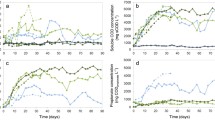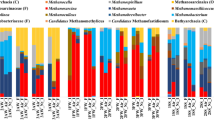Abstract
Anaerobic degradation of organic matter follows similar pathways in digesters and anaerobic freshwater sediments. The responsible microorganisms are linked in a complex food web, where short chain fatty acids and H2 are important intermediates. Degradation of short-chain fatty acids is endothermic under standard conditions and is only possible at low H2 partial pressures maintained by exothermic methanogenesis. The coupling between these endothermic and exothermic processes is delicate, and hence sensitive to environmental changes such as temperature variations. The effect of temperature on thermodynamics and on kinetics of these and other anaerobic degradation processes with emphasis on freshwater ecosystems is discussed.
Similar content being viewed by others
References
BooneD.R. & BryantM.P. 1980 Propionate degrading bacterium Syntrophobacter wolinii sp. nov. gen. nov., from methanogenic ecosystems. Applied and Environmental Microbiology 40, 626–632.
BooneD.R., JohnsonR.L. & LiuY. 1989 Diffusion of the interspecies electron carriers H2 and formate in methanogenic ecosystems and its implication in the measurement of Km for H2 or formate uptake. Applied and Environmental Microbiology 55, 1735–1741.
BuhrH.O. & AndrewsJ.F. 1977 The thermophilic anaerobic digestion process. Water Research 11, 129–143.
ButtonD.K. 1993 Nutrient-limited microbial growth kinetics: overview and recent advances. Antonie van Leeuwenhoek 63, 225–235.
ChinK.-J. & ConradR. 1995 Intermediary metabolism in methanogenic paddy soil and the influence of temperature. FEMS Microbiology Ecology 18, 85–102.
ConradR., SchützH. & BabbelM. 1987 Temperature limitations of hydrogen turnover and methanogenesis in anoxic paddy soil. FEMS Microbiology Ecology 45, 281–289.
ConradR. & WetterB. 1990 Influence of temperature on energetics of hydrogen metabolism in homoacetogenic, methanogenic, and other anaerobic bacteria. Archives of Microbiology 155, 94–98.
DolfingJ. 1988 Acetogenesis. In Biology of anaerobic microorganisms, ed ZehnderA.J.B. pp. 417–468. New York: Wiley Interscience.
DolfingJ. 1992 The energetic consequences of hydrogen gradients in methanogenic ecosystems. FEMS Microbiology Ecology 101, 183–187.
HerbertR.A. & BellC.R. 1977 Growth characteristics of an obligately psychrophilic Vibrio sp. Archives of Microbiology 113, 215–220.
HochachkaP.W. & SomeroG.N. 1984 Biochemical adaptation. Princeton: Princeton University Press.
HugD.H. & HunterJ.K. 1974a Effect of temperature on urocanase from a psychrophile, Pseudomonas putida. Biochemistry 13, 1427–1431.
HugD.H. & HunterJ.K. 1974b Effect of temperature on histidine ammonia-lyase from a psychrophile, Pseudomonas putida. Journal of Bacteriology 119, 92–97.
KnowlesG., DowningA.L. & BarrettM.J. 1965 Determination of kinetic constants for nitrifying bacteria in mixed culture, with the aid of an electronic computer. Journal of General Microbiology 38, 263–278.
KotsyurbenkoO.R., NozhevnikovaA.N. & ZavarzinG.A. 1993 Methanogenic degradation of organic matter by anaerobic bacteria at low temperature. Chemosphere 27, 1745–1761.
LaudeloutH. & vanTichelenL. 1960 Kinetics of the nitrite oxidation by Nitrobacter winogradskyi. Journal of Bacteriology 79, 39–42.
LawA.T. & ButtonD.K. 1977 Multiple-carbon-source-limited growth kinetics of a marine coryneform bacterium. Journal of Bacteriology 129, 115–123.
McInerneyM.J., BryantM.P. & PfennigN. 1979 Anaerobic bacterium that degrades fatty acids in syntrophic association with methanogens. Archives of Microbiology 122, 129–135.
NedwellD.B. & RutterM. 1994 Influence of temperature on growth rate and competition between two psychrotolerant antarctic bacteria: Low temperature diminishes affinity for substrate uptake. Applied and Environmental Microbiology 60, 1984–1992.
RussellJ.B. & BaldwinR.L. 1979 Comparison of maintenance energy expenditures and growth yields among several rumen bacteria grown on continuous culture. Applied and Environmental Microbiology 37, 537–543.
SchinkB. 1988 Principles and limits of anaerobic degradation: Environmental and technological aspects. In Biology of anaerobic microorganisms, ed ZehnderA.J.B. pp. 771–846. New York: Wiley Interscience.
SchinkB. & FriedrichM. 1994 Energetics of syntrophic fatty acid oxidation. FEMS Microbiology Reviews 15, 85–94.
StummW. & MorganJ.J. 1981 Aquatic Chemistry 2nd. edition New York: Wiley Interscience.
ThauerR.K., JungermannK. & DeckerK. 1977 Energy conservation in chemoautotrophic anaerobic bacteria. Bacteriological Reviews 41, 100–180.
VerduynC. 1991 Physiology of yeasts in relation to biomass yields. Antonie van Leeuwenhoek 60, 325–353.
WatsonR.T., RodheH., OeschgerH. & SiegenthalerU. 1990 Greenhouse gases and aerosols. In Climate Change. The IPPC Scientific Assessment, eds HoughtonJ.T., JenkinsG.J. & EphraumsJ.J. pp. 1–41. Cambridge: Cambridge University Press.
WestermannP. 1993 Temperature regulation of methanogenesis in wetlands. Chemosphere 26, 321–328.
WestermannP. 1994 The effect of incubation temperature on steady-state concentrations of hydrogen and volatile fatty acids during anaerobic degradation in slurries from wetland sediments. FEMS Microbiology Ecology 13, 295–230
WestermannP. & AhringB.K. 1987 Dynamics of methane production, sulfate reduction and denitrification in a permanently waterlogged alder swamp. Applied and Environmental Microbiology 53, 2554–2559.
WestermannP., AhringB.K. & MahR.A. 1989 Temperature compensation in Methanosarcina barkeri by modulation of hydrogen and acetate affinity. Applied and Environmental Microbiology 55, 1262–1266.
WhitingG.J. & ChantonJ.P. 1993 Primary production control of methane emission from wetlands. Nature 364, 794–795.
WolinM.J. 1982 Hydrogen transfer in microbial communities. In Microbial interactions and communities, eds BullA.T. & SlaterJ.H. pp. 323–357. London: Academic Press.
Additional information
The author is with the Department of General Microbiology, Institute of Molecular Biology, University of Copenhagen, Sølvgade 83 H, DK-1307 Copenhagen K, Denmark
Rights and permissions
About this article
Cite this article
Westermann, P. Temperature regulation of anaerobic degradation of organic matter. World J Microbiol Biotechnol 12, 497–503 (1996). https://doi.org/10.1007/BF00419463
Issue Date:
DOI: https://doi.org/10.1007/BF00419463




